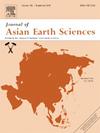青藏高原南部南向裂谷的构造变化:来自热液排放和地震活动的见解
IF 2.4
3区 地球科学
Q2 GEOSCIENCES, MULTIDISCIPLINARY
引用次数: 0
摘要
青藏高原内部的一系列ns向裂谷为揭示其裂谷性质和地球动力学机制提供了一个窗口。本文主要通过热液脱气和地震活动来确定各裂谷的不同构造状态。热液气体组分分析表明,地壳变质产物在西部裂谷和最东部裂谷聚集,而东北裂谷带的地幔源挥发物则在增长。上升地幔流体的流速为0.01 mm/yr ~ 2972 mm/yr,总3He通量为1.0 × 10−7 ~ 1.2 × 10−5 mol/km2/yr。富h2温泉的分布与裂谷的年轻起始时间吻合,表明东部裂谷处于年轻的活动构造环境。在地震活动中也观察到空间可辨别的特征。发生在西部裂谷的地震震源深度相对较浅,频率和震级较低,表明中浅层地壳内断裂构造活跃。相比之下,东北部裂谷区发生的强地震和深震源地震更为频繁,勾勒出了大型断层平面,这些断层平面深入下地壳甚至岩石圈底部,并为地表地幔源挥发物的贡献日益增加提供了增强通道。我们的解释强调,下伏的印度板块不太可能在西藏下方经历大面积撕裂,向东增强的地震活动和脱气可能是由向东传播的横向板块分离驱动的。这些发现对青藏高原碰撞后的演化具有重要意义。本文章由计算机程序翻译,如有差异,请以英文原文为准。

Tectonic variations in NS-trending rifts, southern Tibetan Plateau: insights from hydrothermal emissions and seismic activities
A series of NS-trending rifts in the Tibetan Plateau interior provide a window for unraveling its rifting properties and geodynamic mechanisms. In this study, we focused on hydrothermal degassing and seismic activities to identify the differential tectonic status of each rift. Analysis of hydrothermal gaseous components reveals that crustal metamorphic products accumulate in the western rifts and the easternmost rift while growing mantle-derived volatiles contribute in the northeast rifting zones. The flow rate of uprising mantle-derived fluids ranges from 0.01 mm/yr to 2972 mm/yr and the total 3He fluxes vary in 1.0 × 10−7 – 1.2 × 10−5 mol/km2/yr. The distribution of H2-enriched hot springs coincides with the young initiation time of the rifts, indicating the young active tectonic setting in the eastern rifts. Spatially discernible characteristics are also observed in seismic activity. Earthquakes occurring in western rifts have relatively shallow focal depths and low frequencies and magnitudes, suggesting that faulting structures are active within the middle-shallow crust. In contrast, more frequent strong and deep-focus earthquakes occurred in the northeastern rifting areas, outlining the large-scale fault planes that dipped into the lower crust or even the bottom of the lithosphere and served as an enhanced conduit for the growing contribution of mantle-derived volatiles at the surface. Our interpretation emphasizes that the underlying Indian slab is unlikely to experience wide tearing beneath Tibet and that eastward-enhanced seismic activity and degassing are likely driven by eastward-propagating lateral slab detachment. These findings have profound implications for the post-collisional evolution of the Tibetan Plateau.
求助全文
通过发布文献求助,成功后即可免费获取论文全文。
去求助
来源期刊

Journal of Asian Earth Sciences
地学-地球科学综合
CiteScore
5.90
自引率
10.00%
发文量
324
审稿时长
71 days
期刊介绍:
Journal of Asian Earth Sciences has an open access mirror journal Journal of Asian Earth Sciences: X, sharing the same aims and scope, editorial team, submission system and rigorous peer review.
The Journal of Asian Earth Sciences is an international interdisciplinary journal devoted to all aspects of research related to the solid Earth Sciences of Asia. The Journal publishes high quality, peer-reviewed scientific papers on the regional geology, tectonics, geochemistry and geophysics of Asia. It will be devoted primarily to research papers but short communications relating to new developments of broad interest, reviews and book reviews will also be included. Papers must have international appeal and should present work of more than local significance.
The scope includes deep processes of the Asian continent and its adjacent oceans; seismology and earthquakes; orogeny, magmatism, metamorphism and volcanism; growth, deformation and destruction of the Asian crust; crust-mantle interaction; evolution of life (early life, biostratigraphy, biogeography and mass-extinction); fluids, fluxes and reservoirs of mineral and energy resources; surface processes (weathering, erosion, transport and deposition of sediments) and resulting geomorphology; and the response of the Earth to global climate change as viewed within the Asian continent and surrounding oceans.
 求助内容:
求助内容: 应助结果提醒方式:
应助结果提醒方式:


